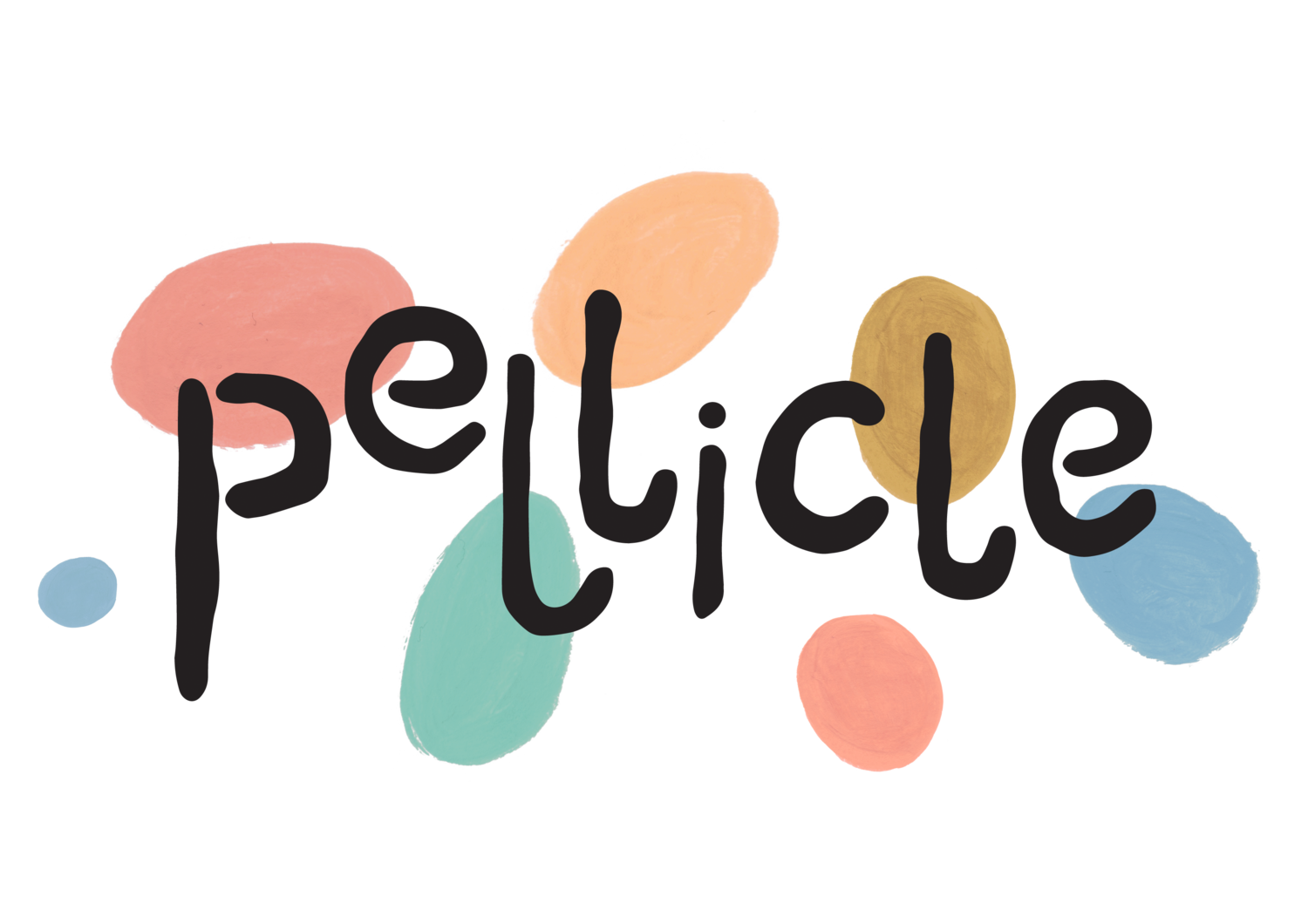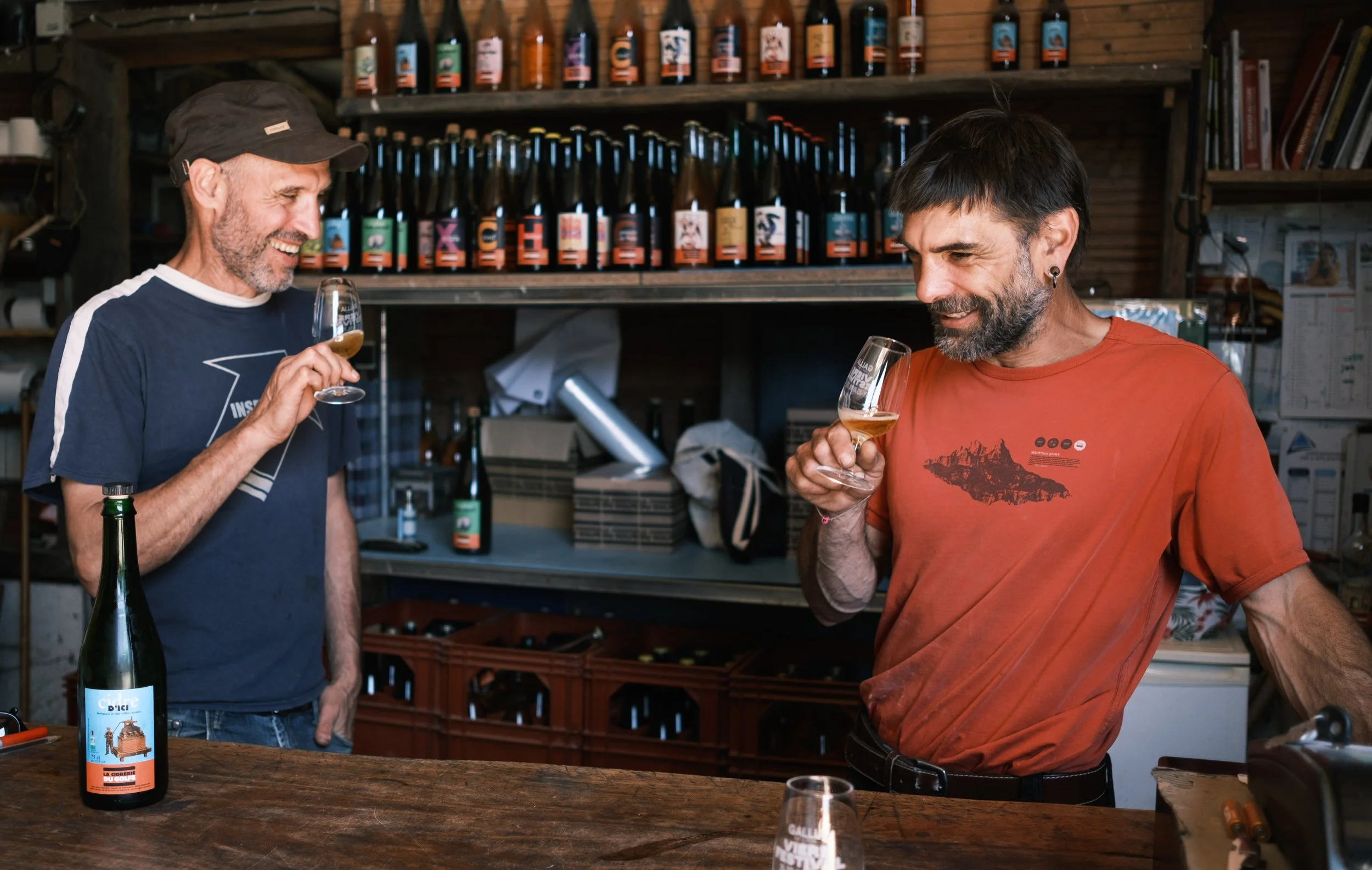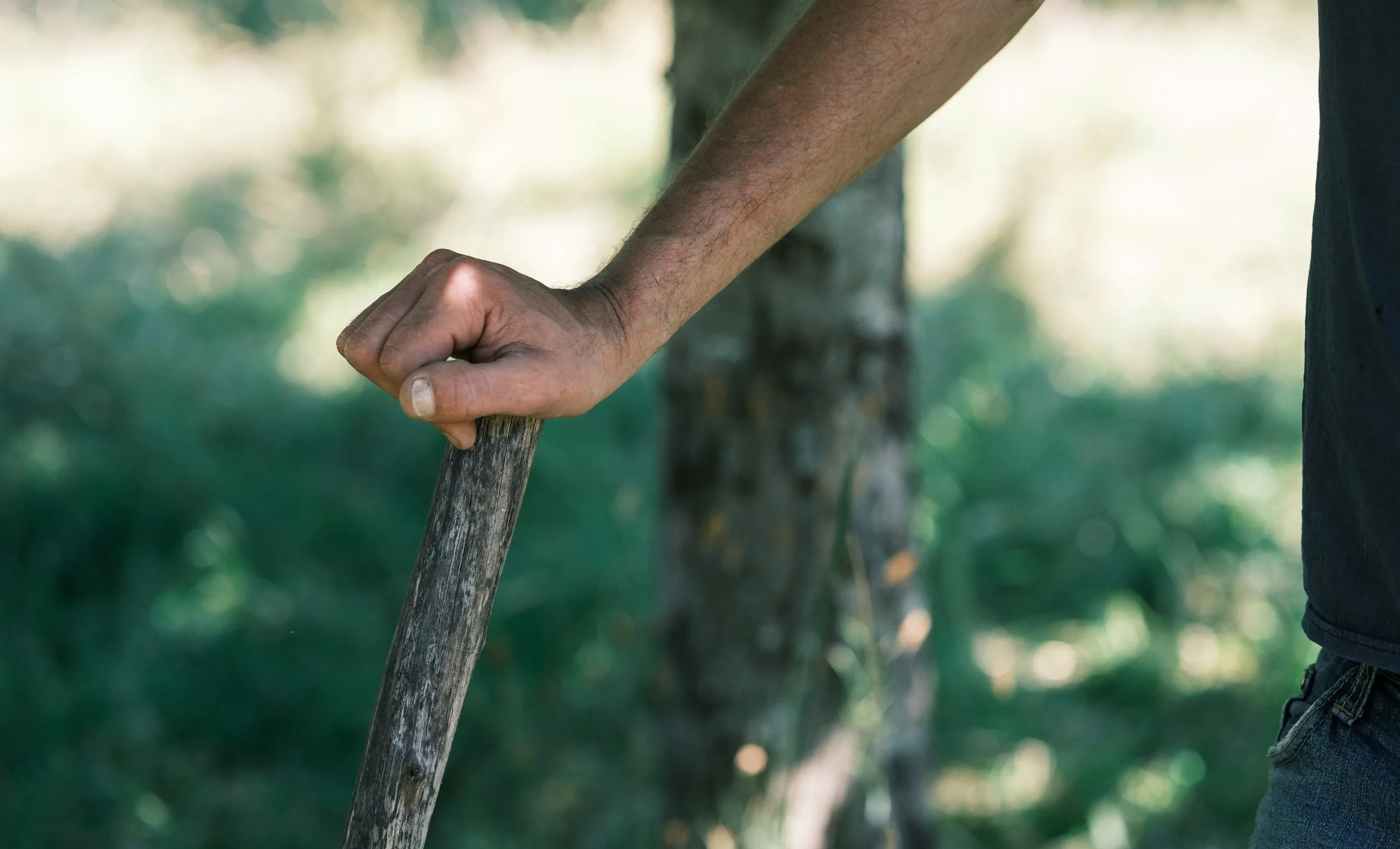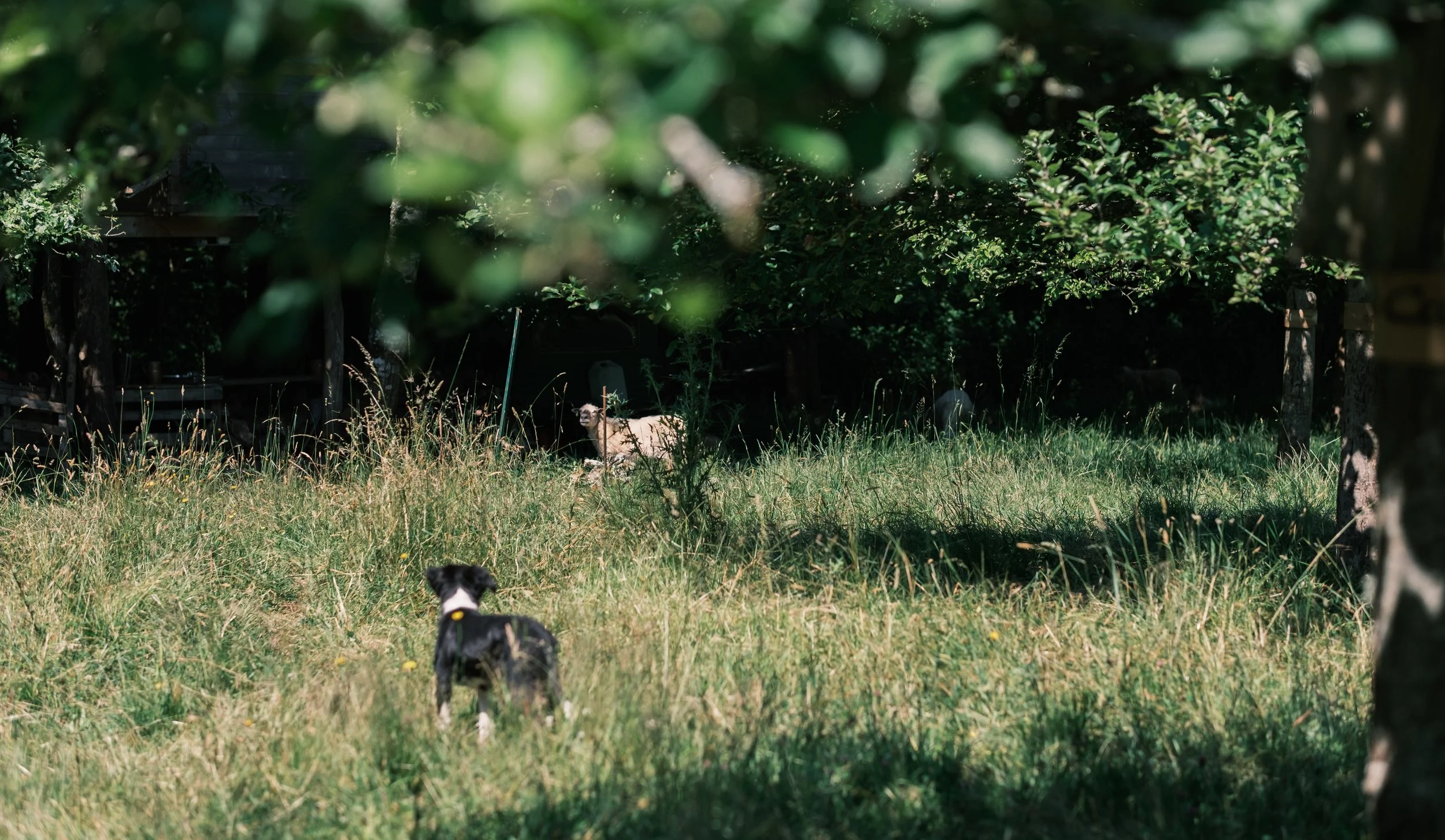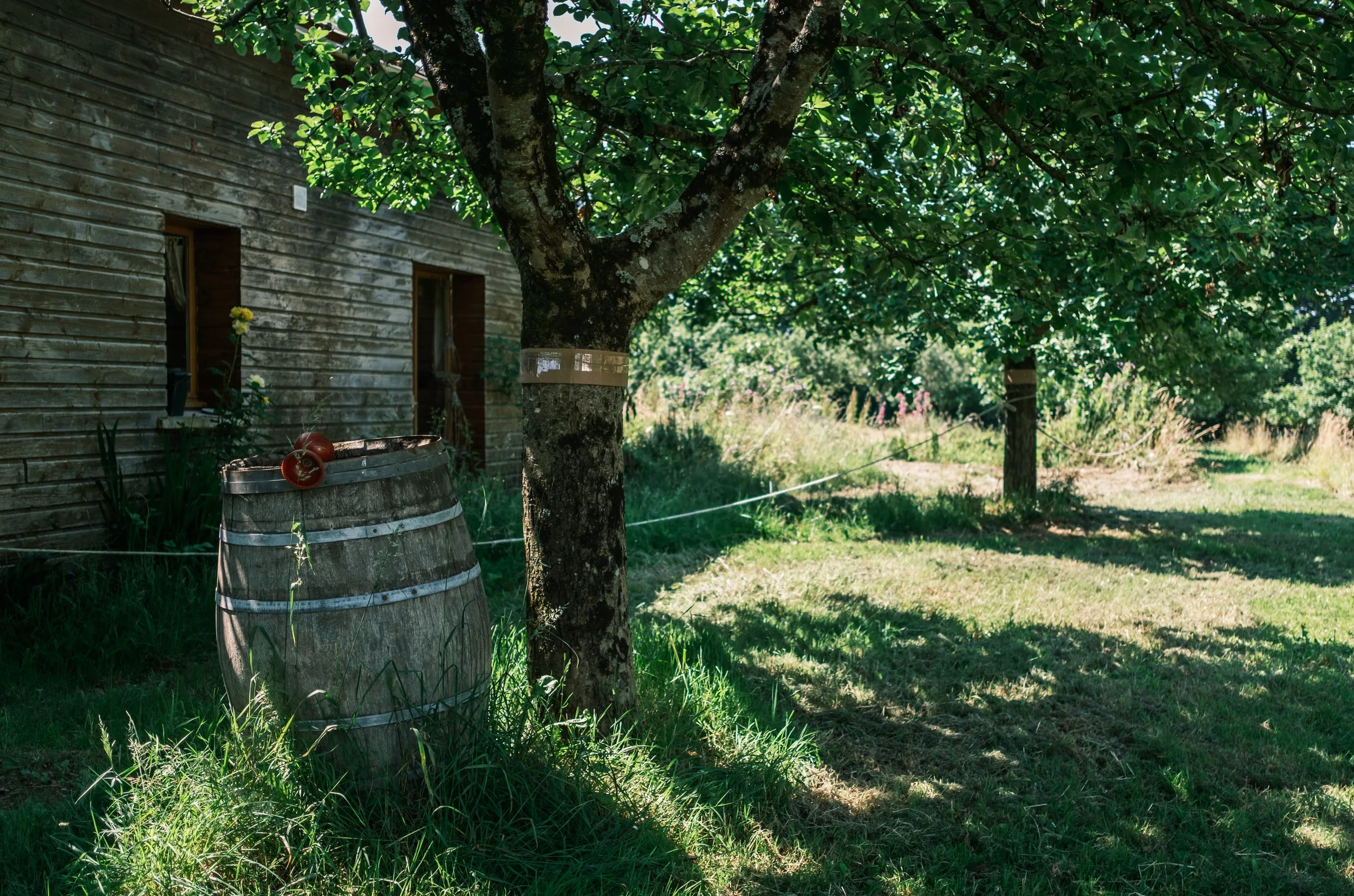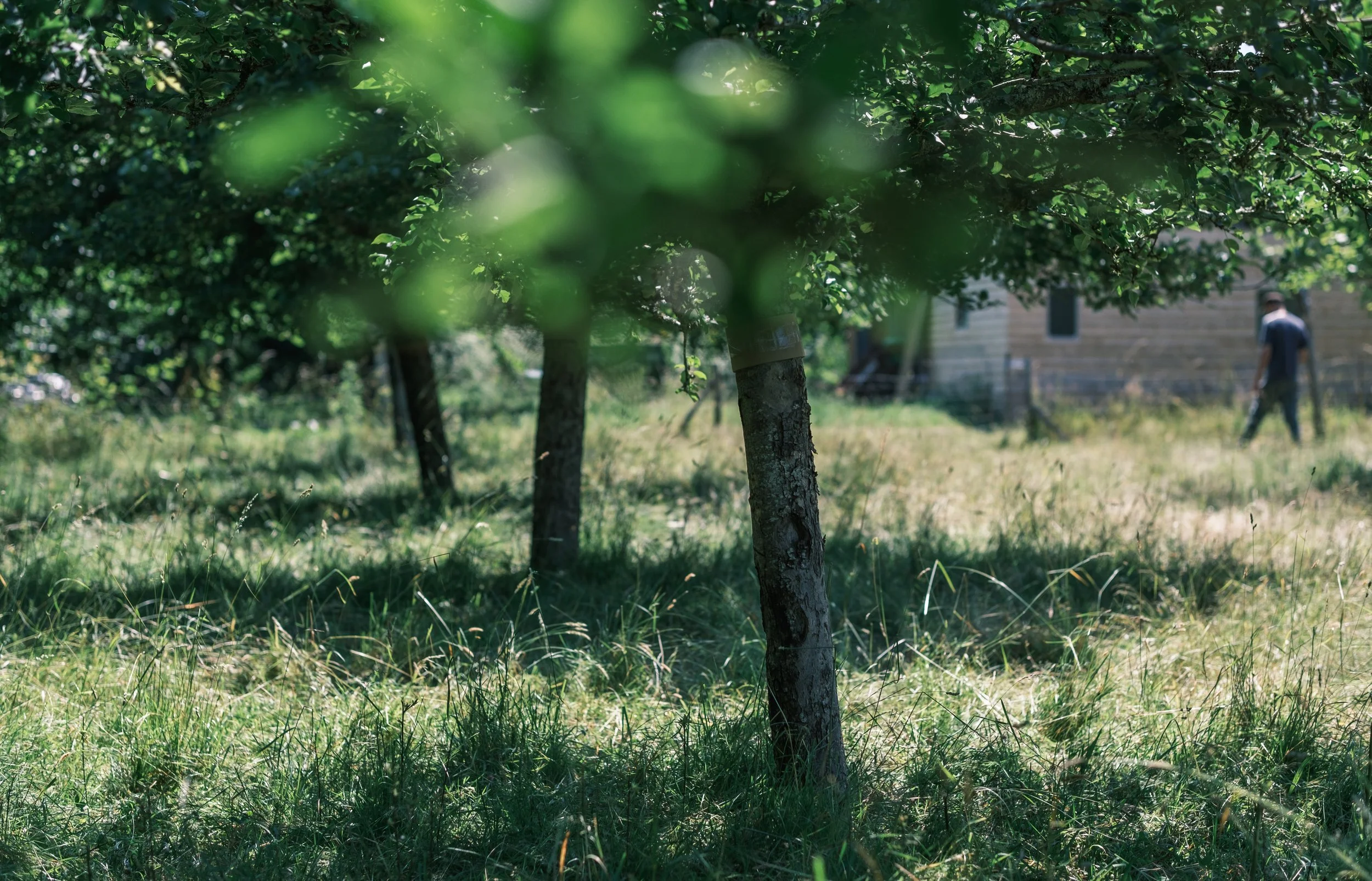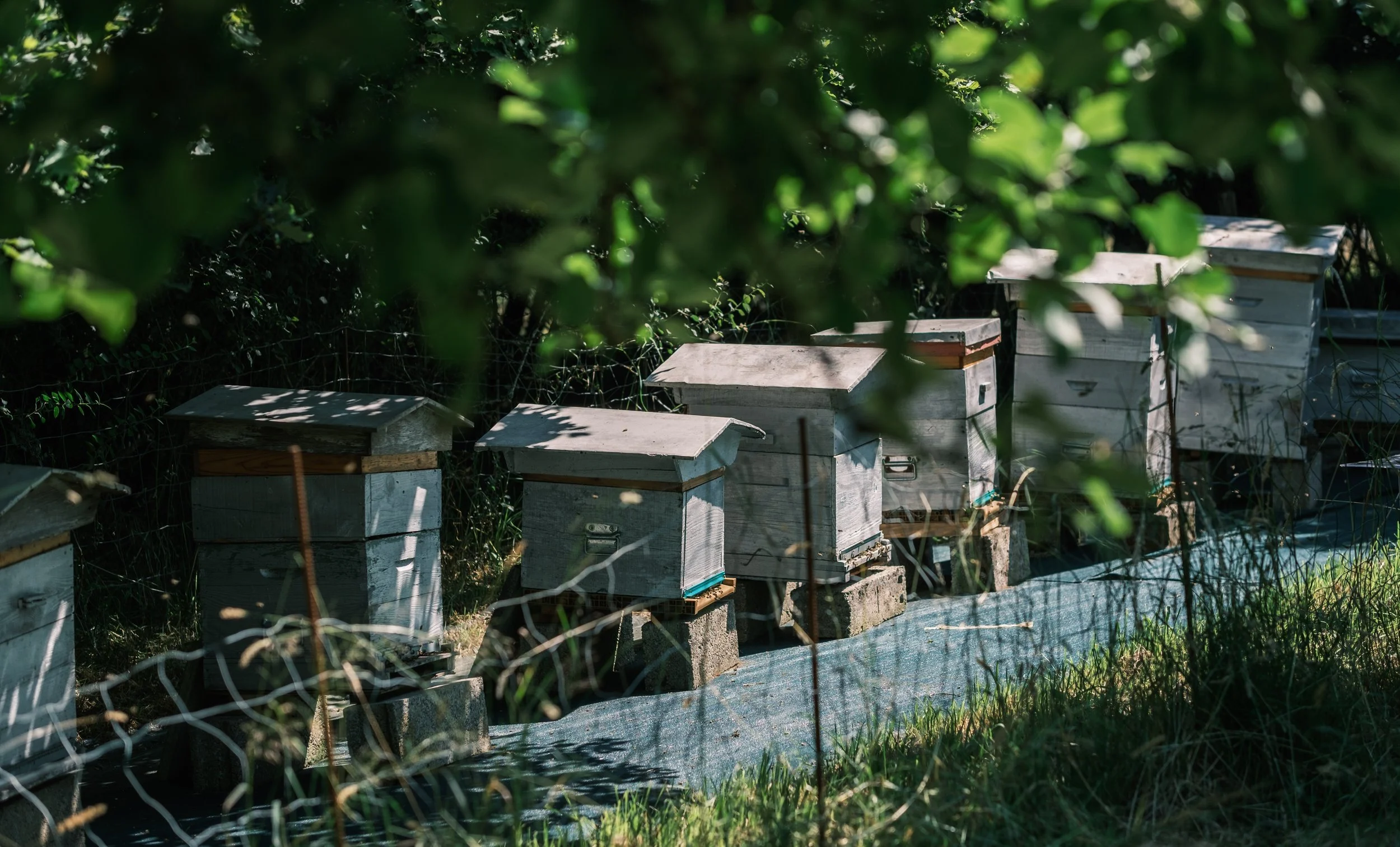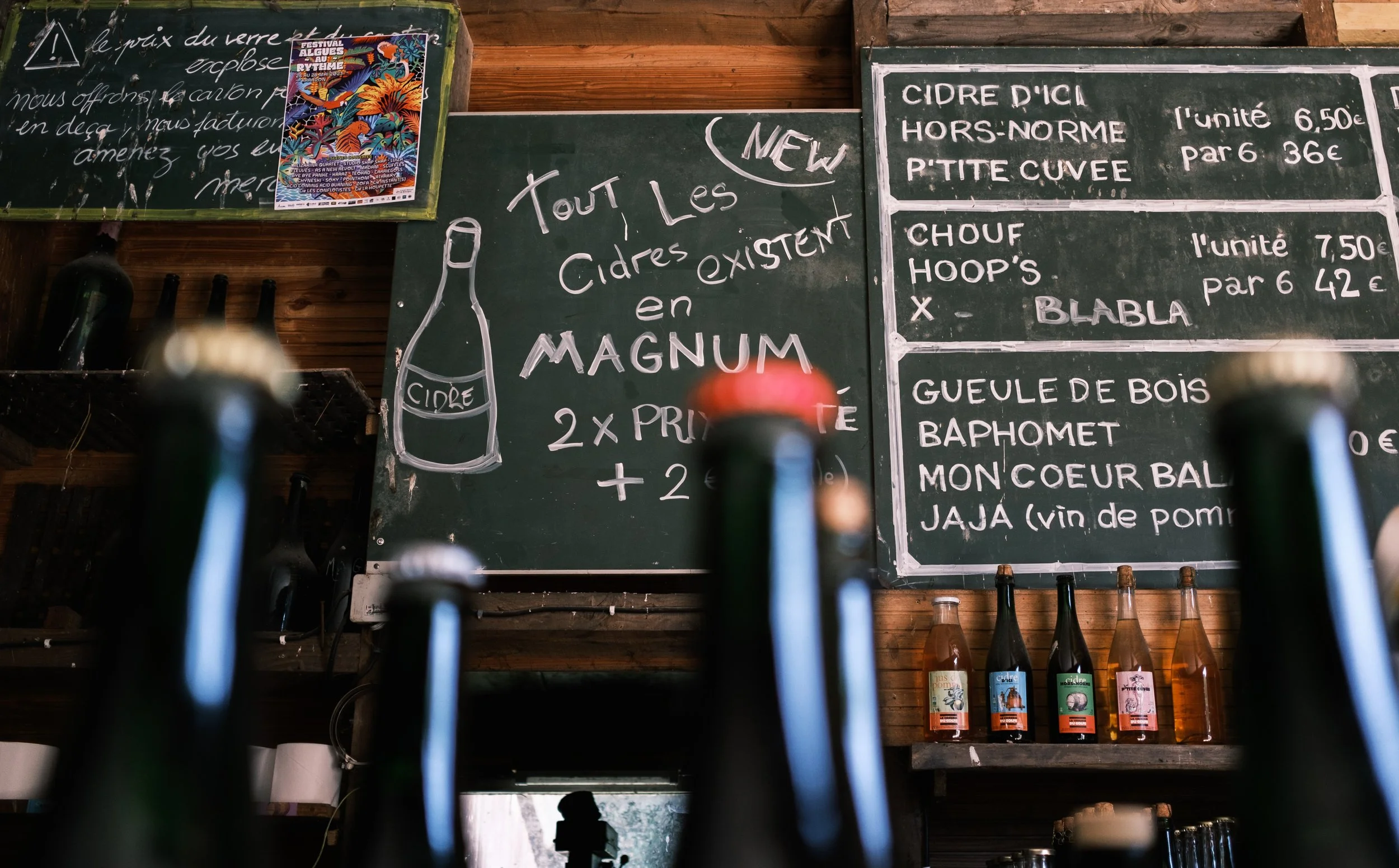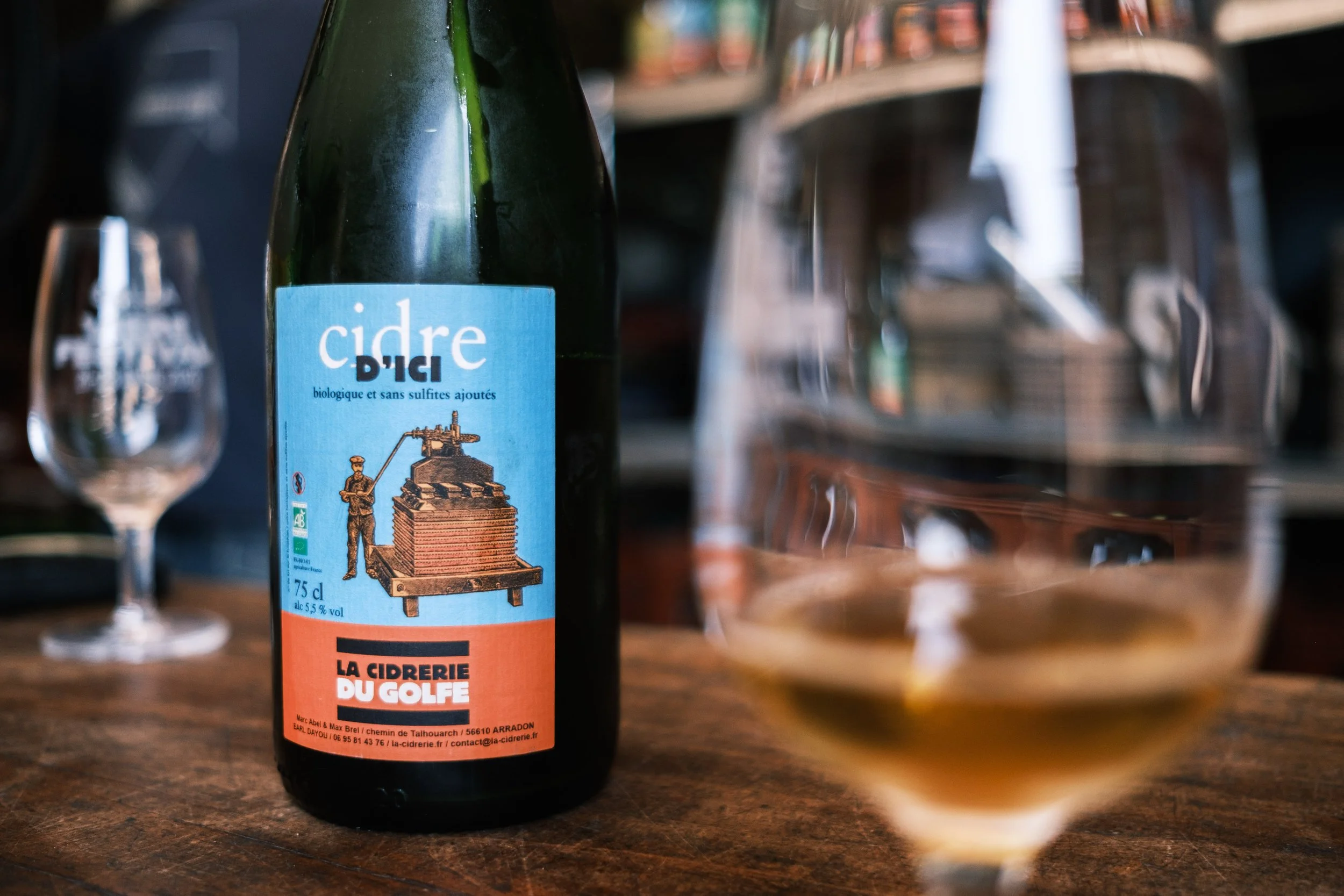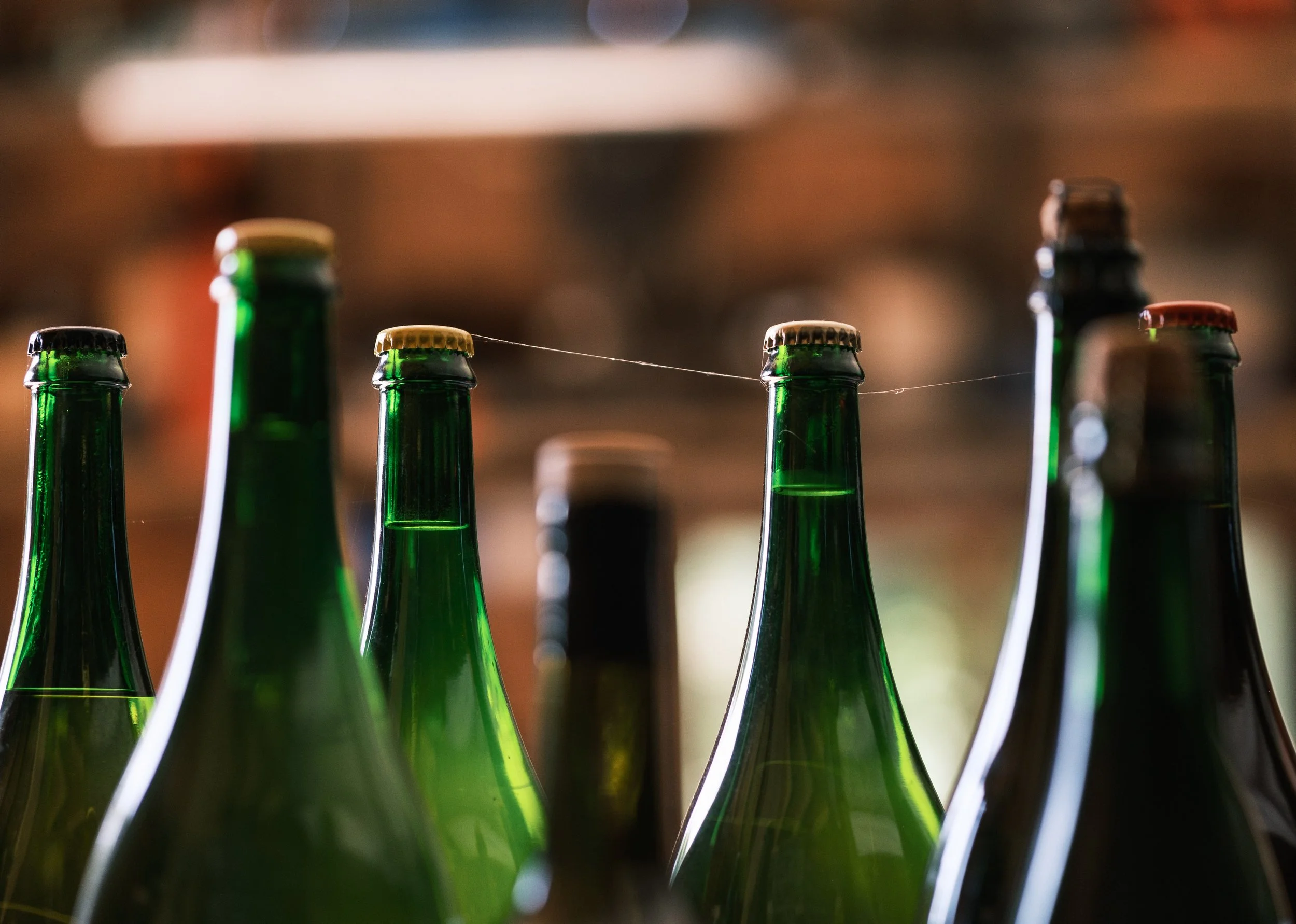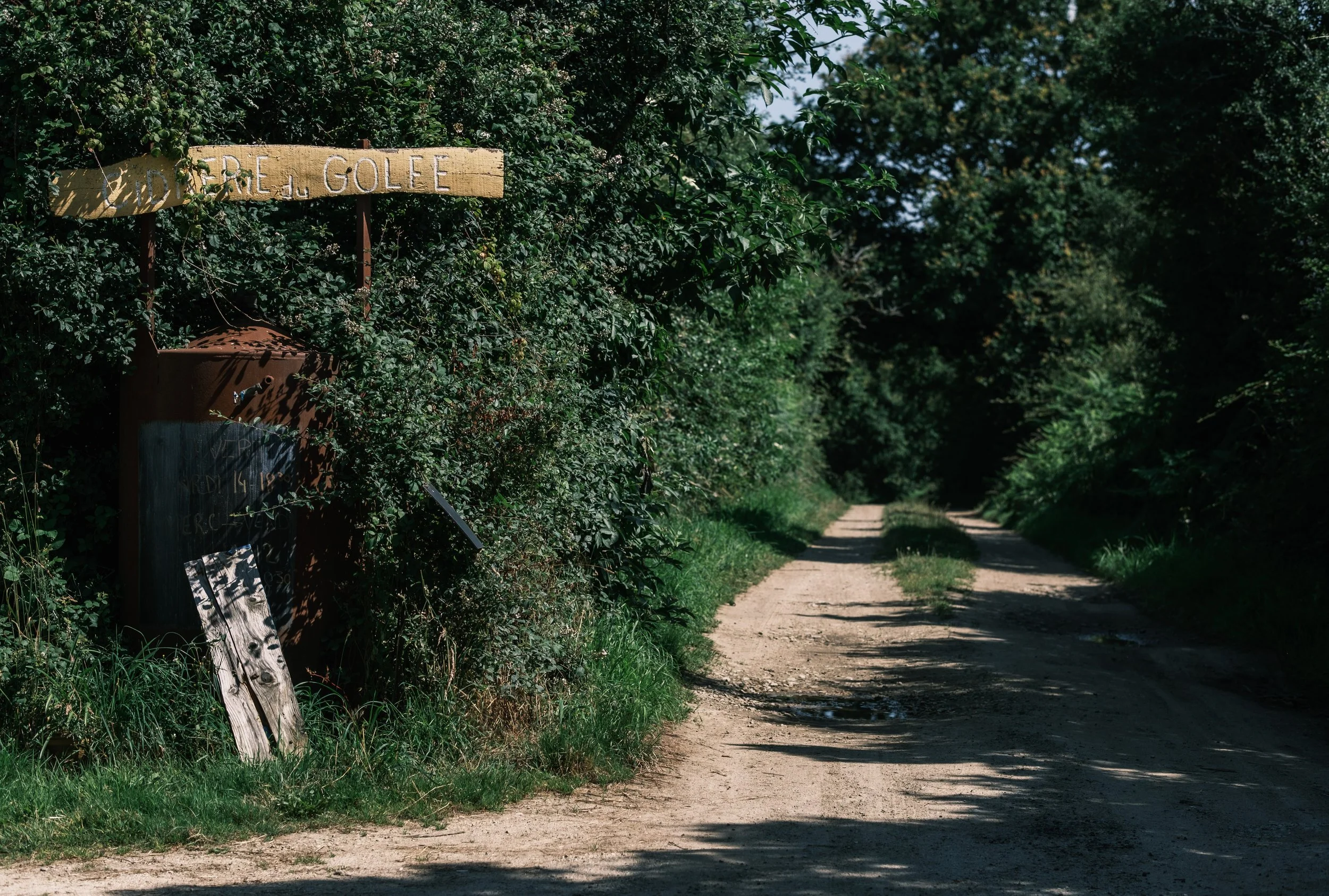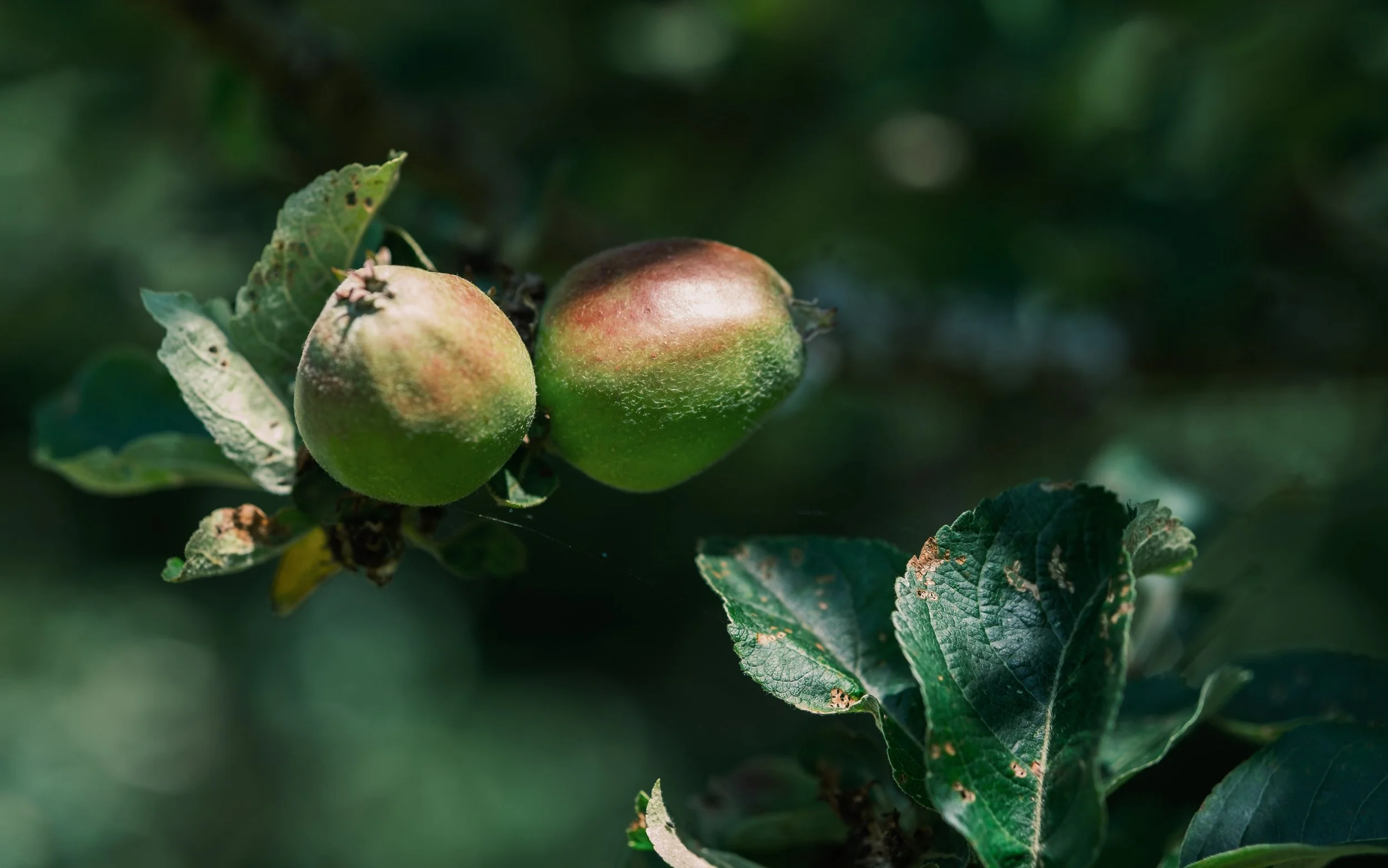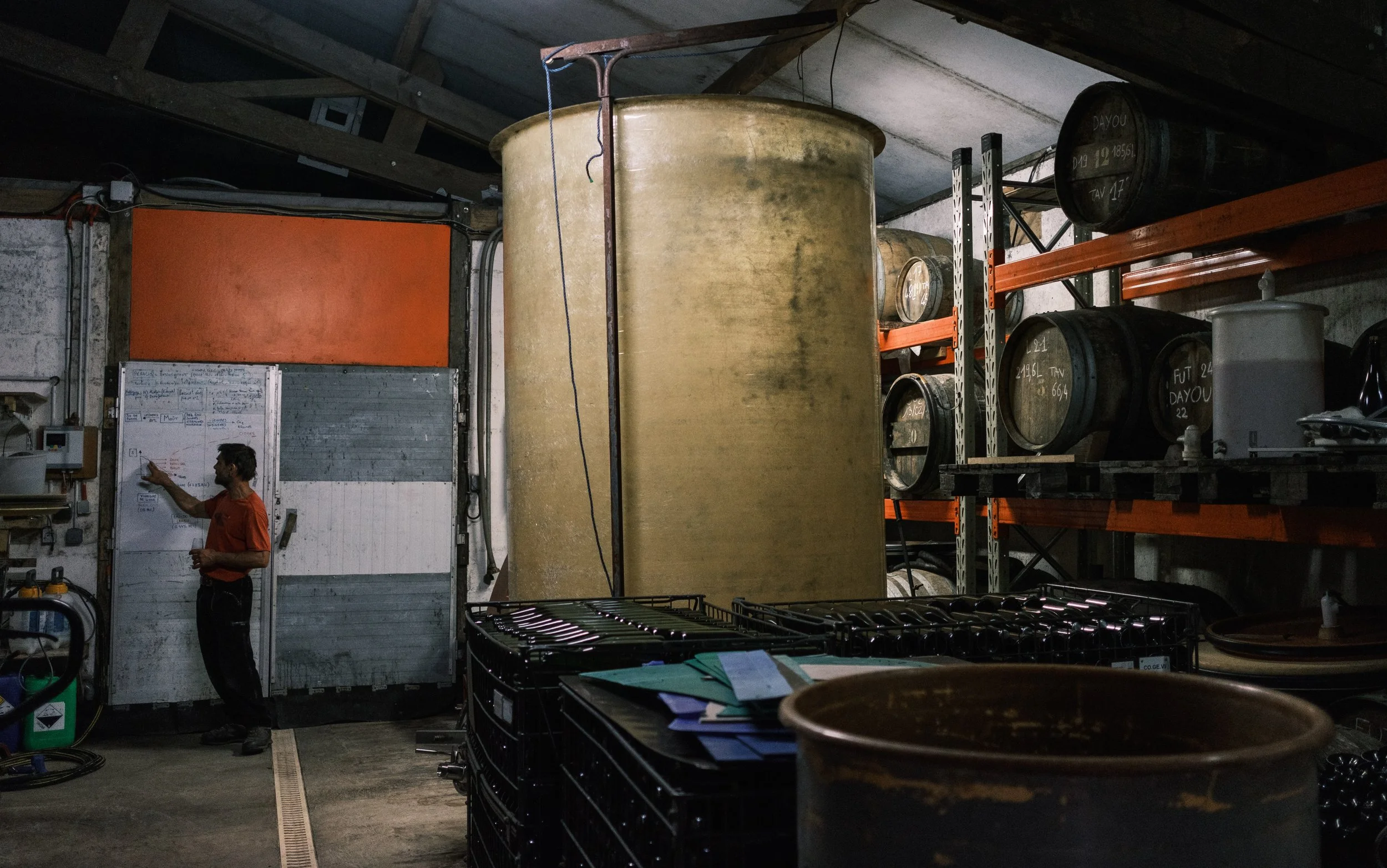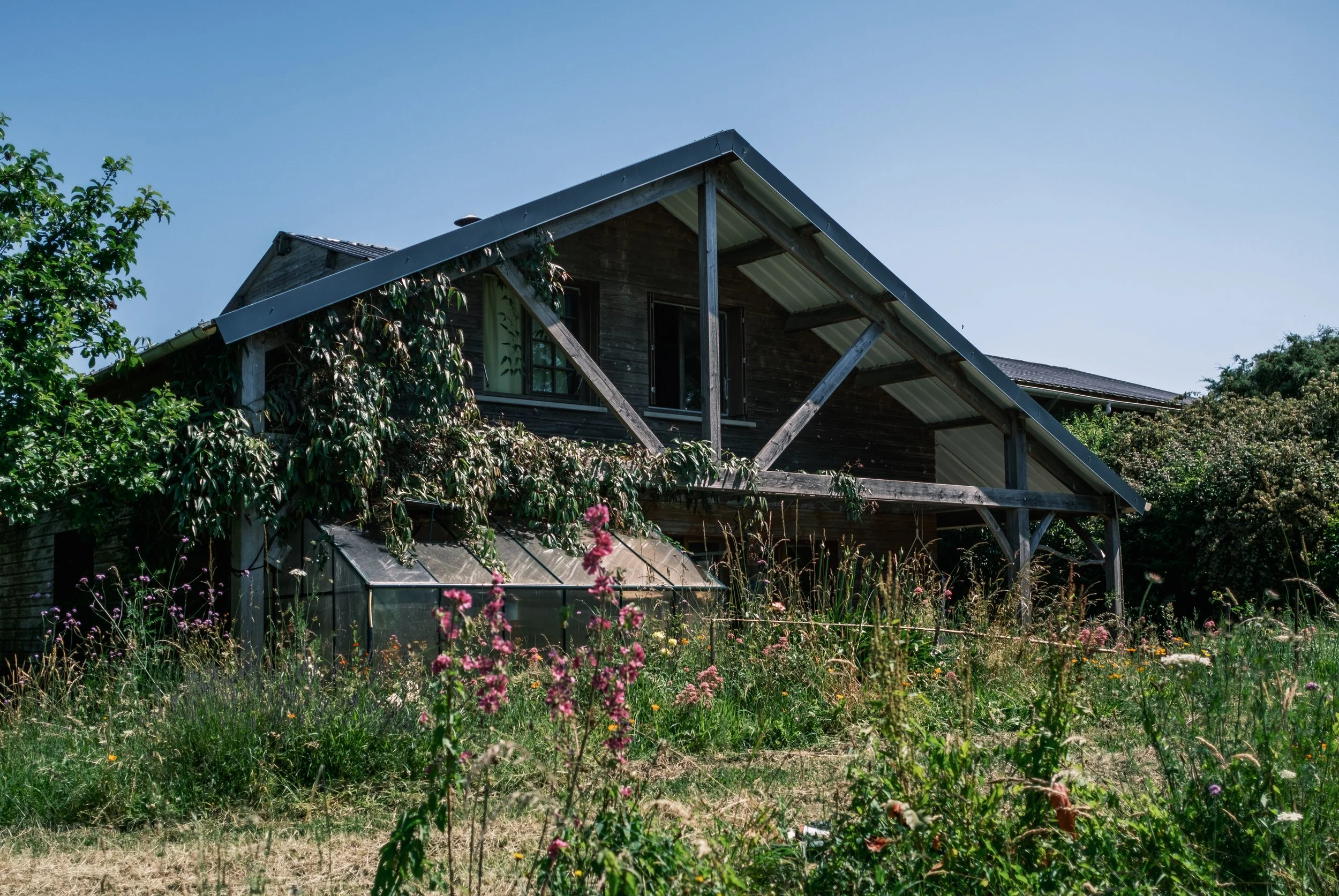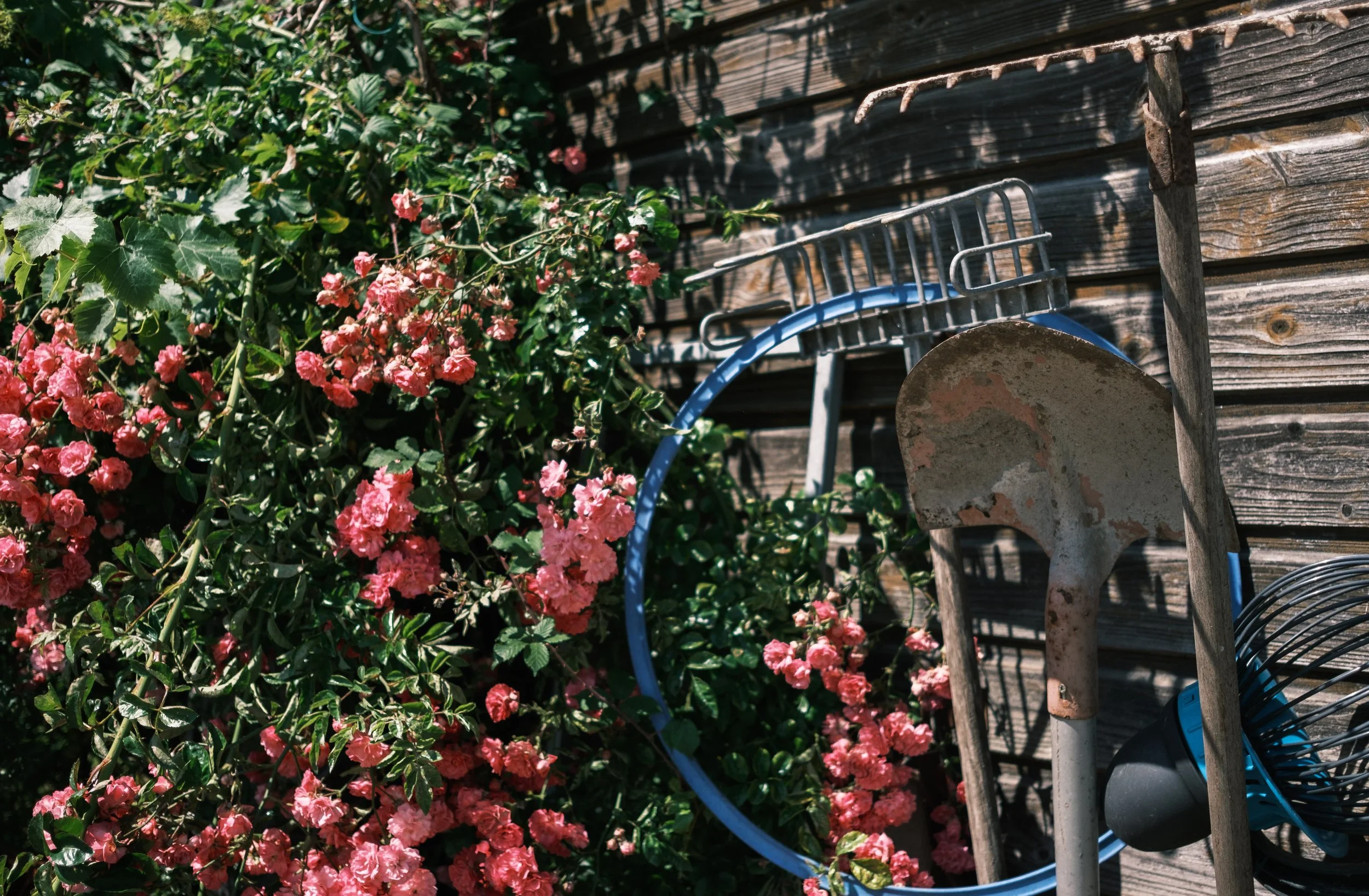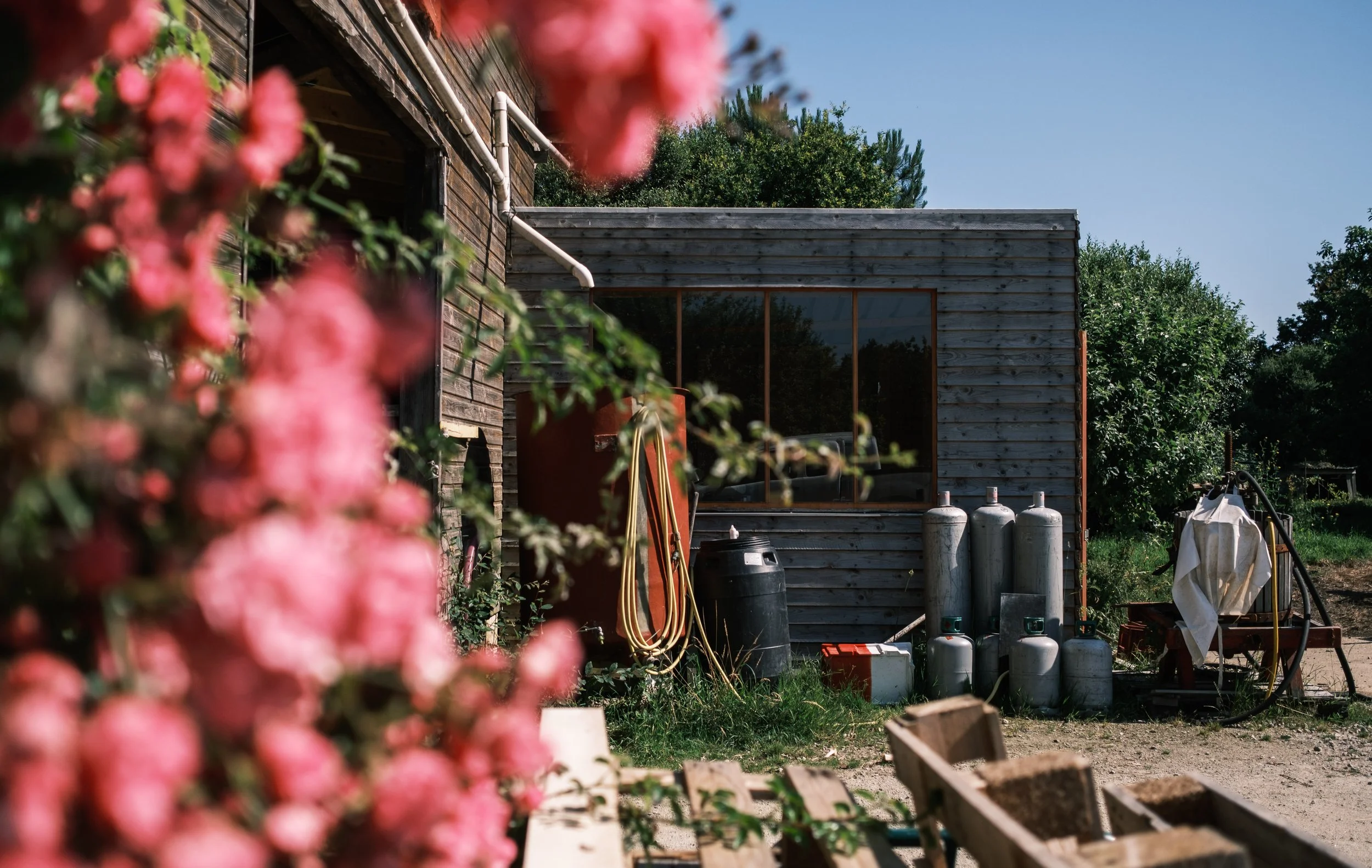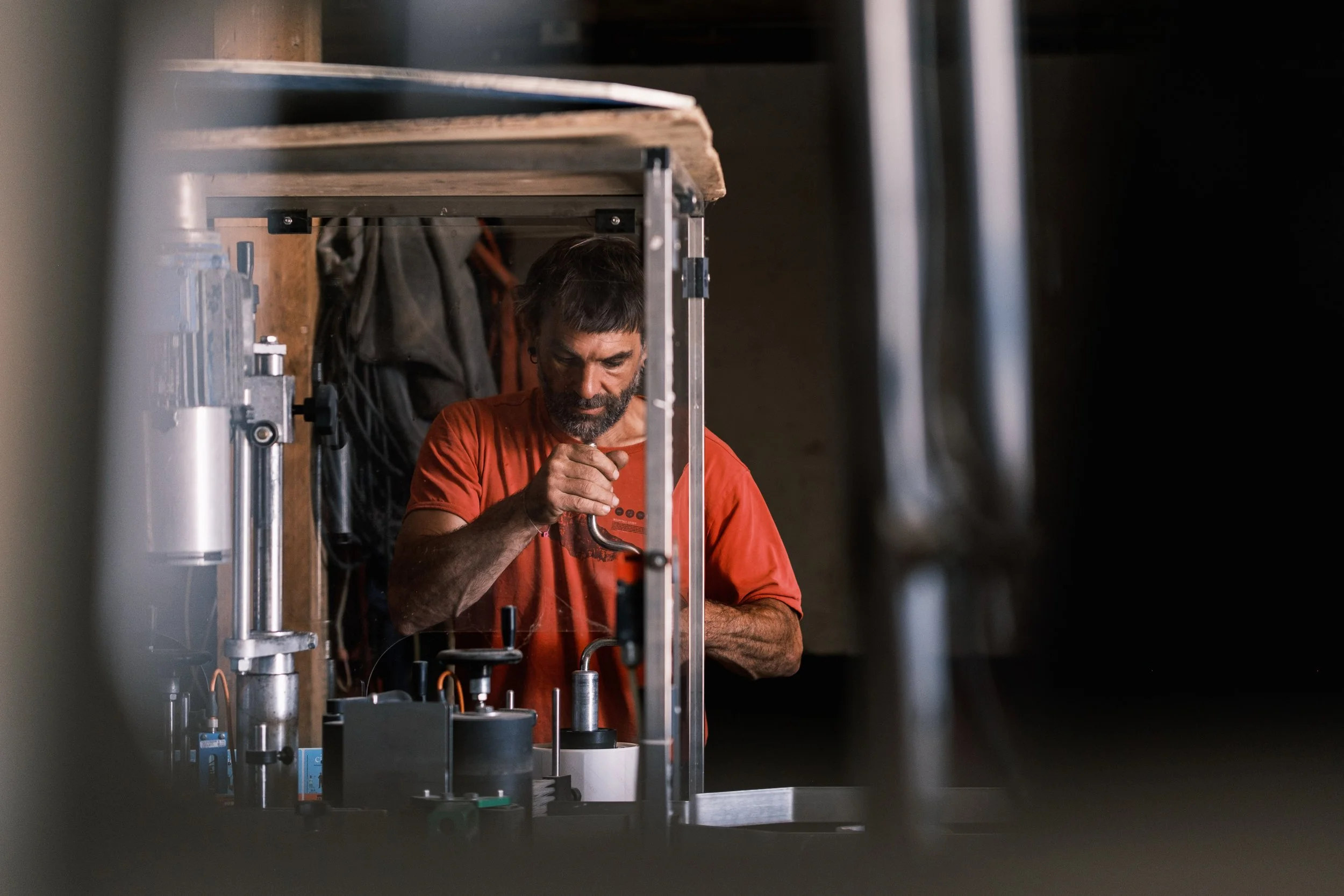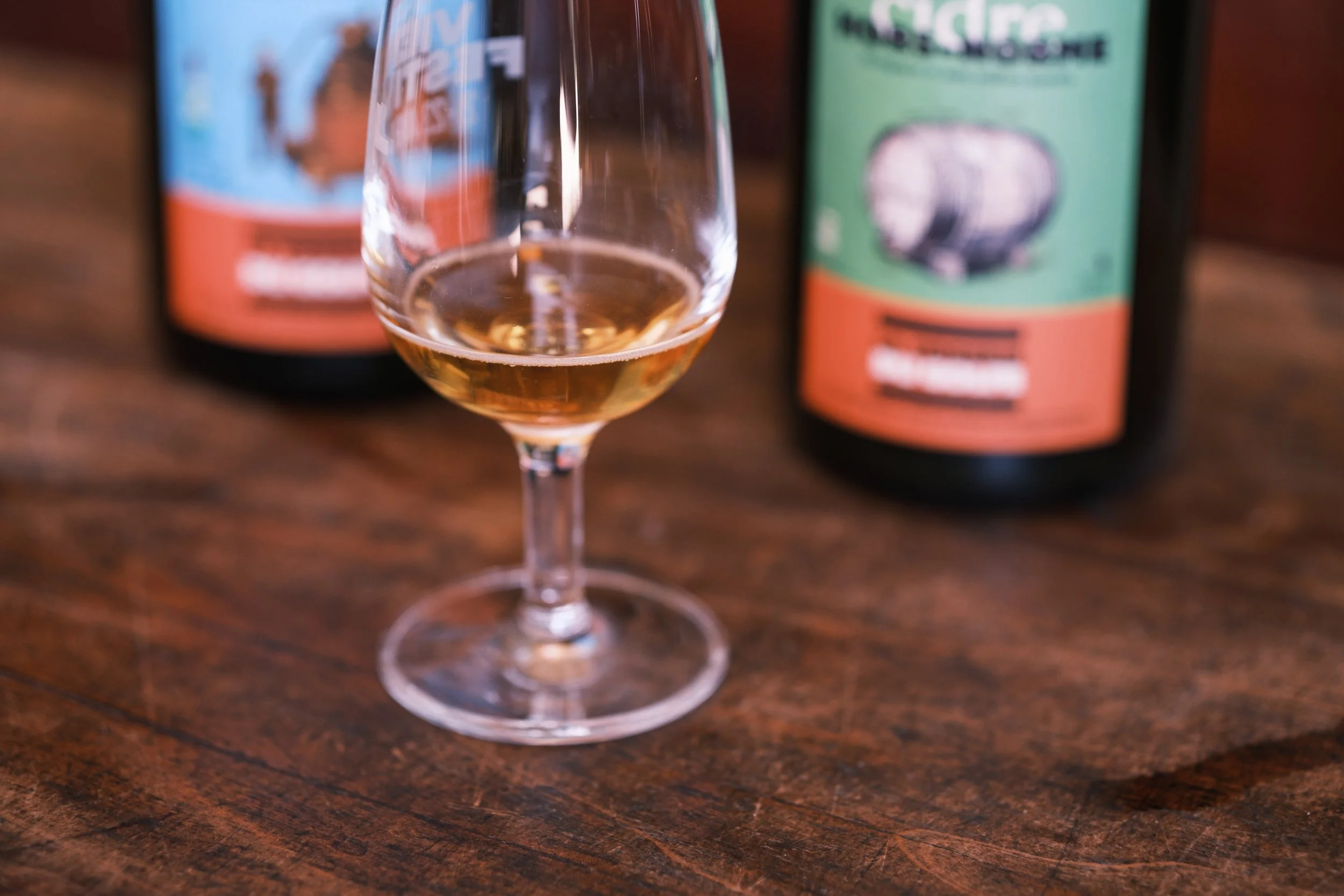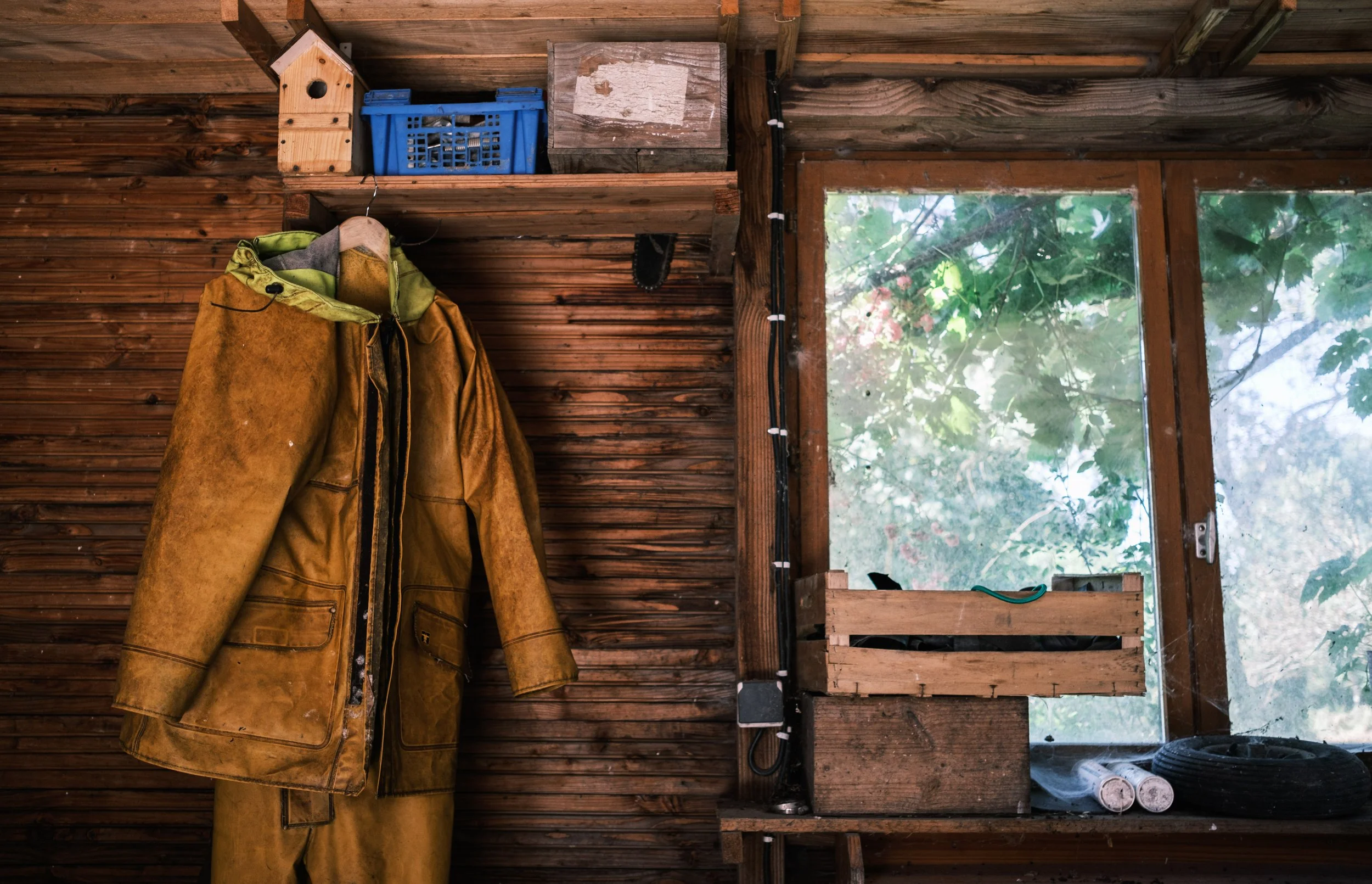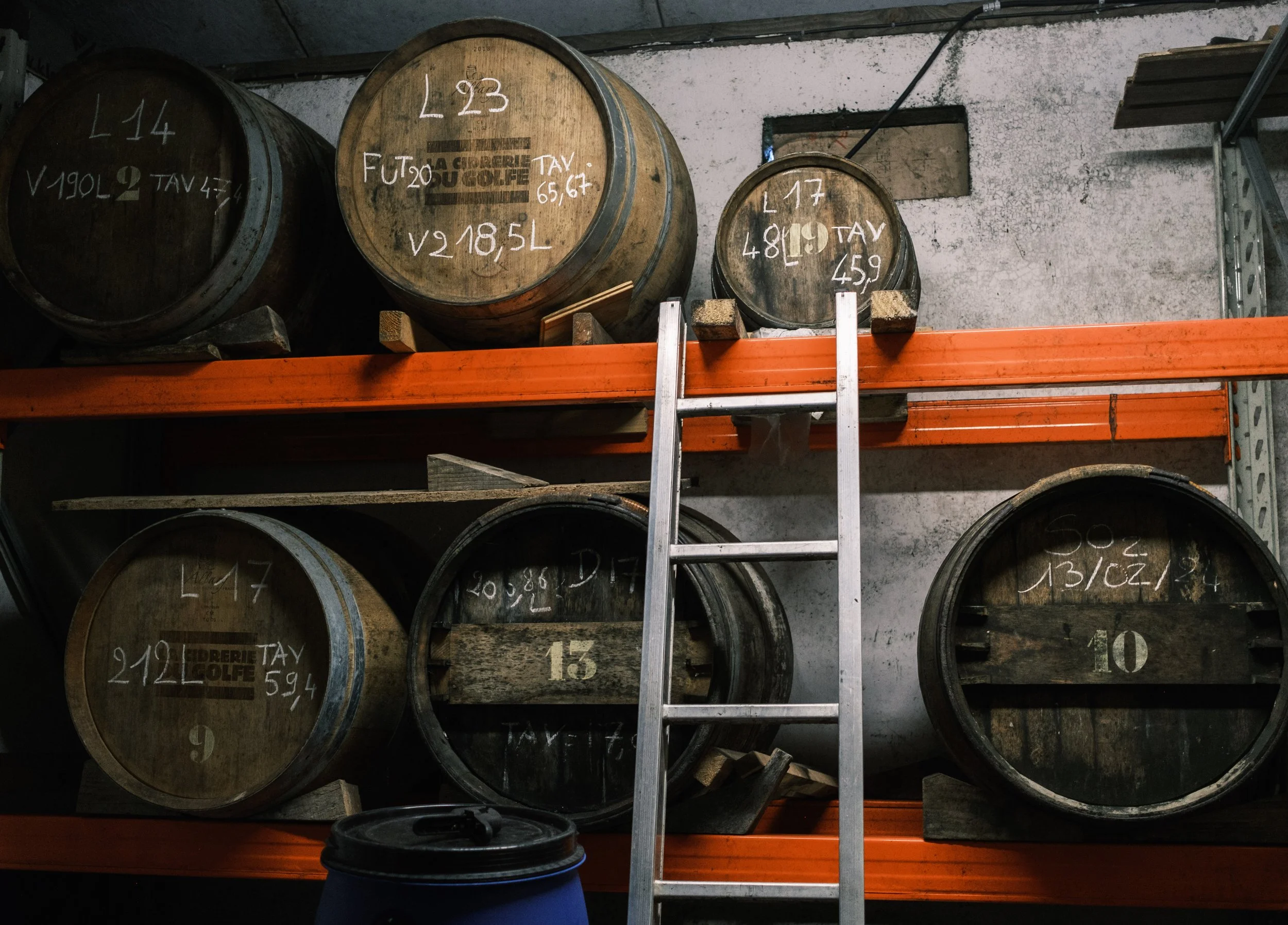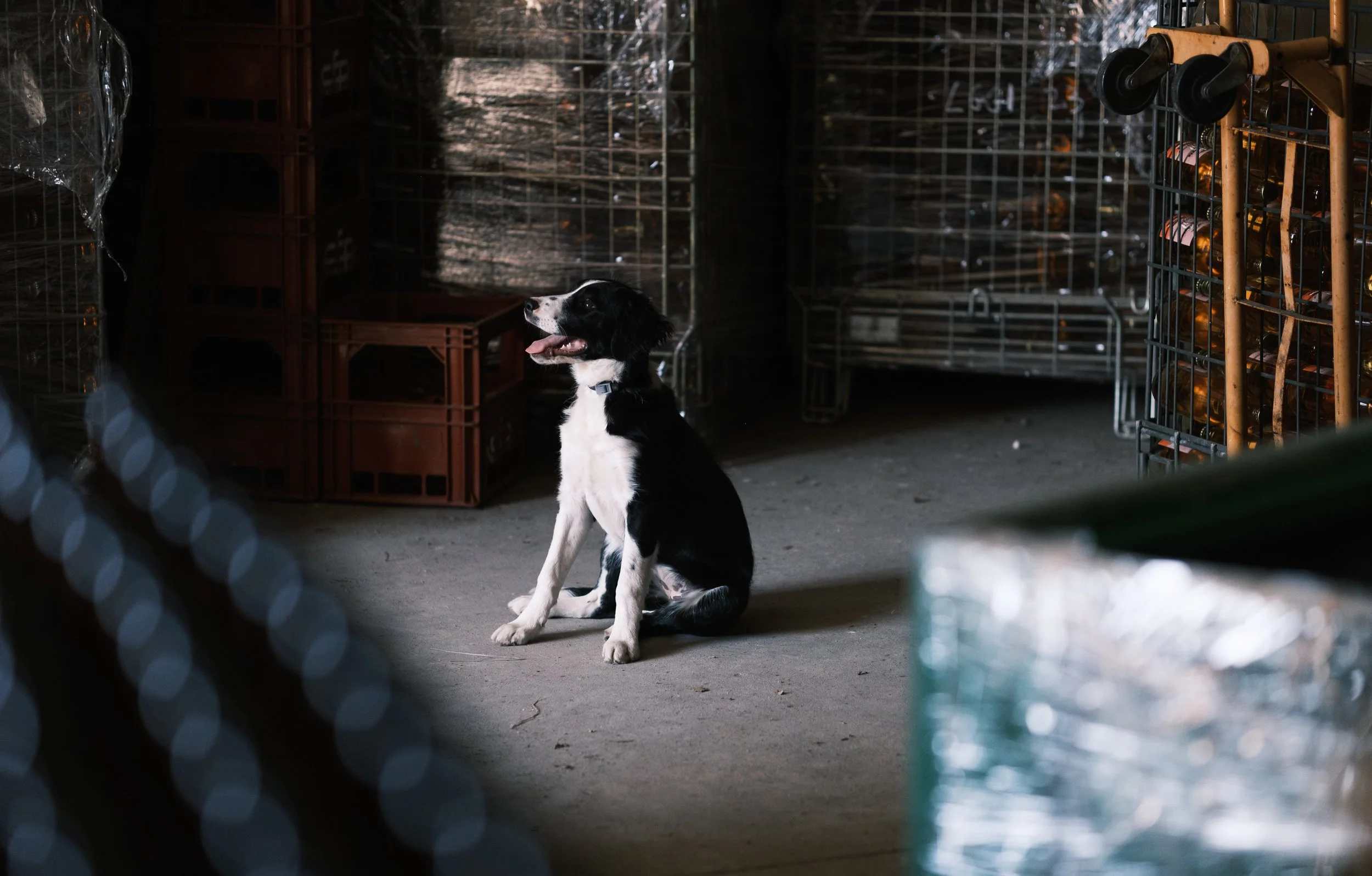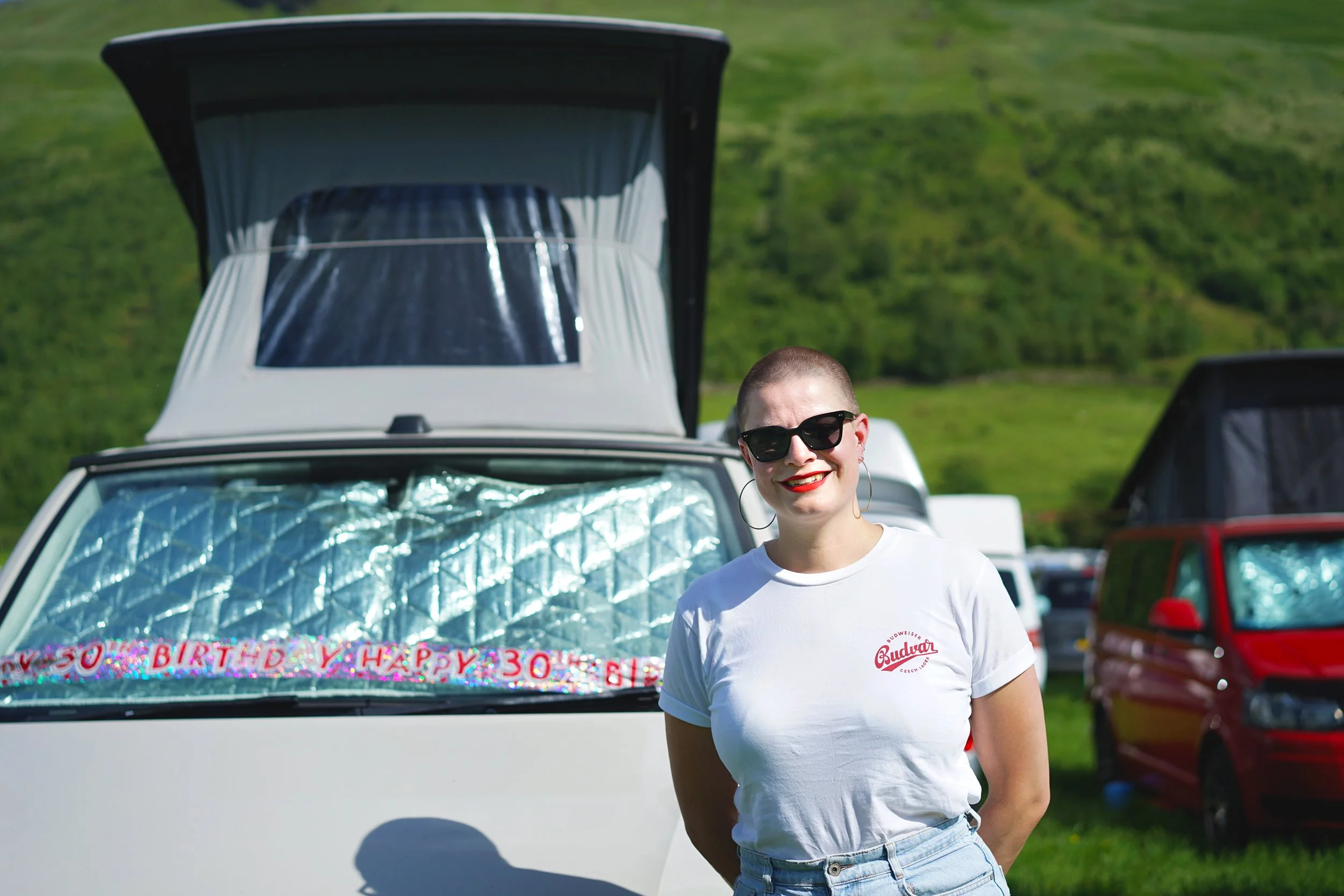Reject Waste, Embrace Creativity — Cidrerie du Golfe in Brittany, France
Underneath the shade of apple trees, Joy, an energetic five-month-old puppy, fails to catch butterflies.
“We’re training her to guard sheep, but I’m not the best at authority,” Marc Abel says laughing, while Joy wanders away, oblivious to any of his commands.
On this hot Summer day, enjoying the coolness the branches provide and unbothered by Joy’s playfulness, the sheep peacefully nibble grass, unherded.
Thanks to this essential work, Marc Abel and Max Brel, owners of Cidrerie du Golfe in the small seaside town of Arradon, south Brittany, no longer mow their fifteen acres of land mechanically or amend the soils, putting their tractor to rest—they proudly state that it only requires 80 litres of gasoline per year.
The wooden stick Marc holds currently serves as the biggest tool in the orchard.
Photography by Claire-Marie Luttun
“We let the apples fall by themselves but they sometimes need a little help,” he says as he uses the stick to demonstrate. “We do everything by hand, it also allows us to only gather apples we need for each recipe and let the other mature.”
Strolling through this lush orchard, buzzing with nature, it’s hard to imagine the state Cidrerie du Golfe was in when Marc first stepped in it during 2012 with his first associate François Desforges, (Max joined them in 2020, before François retired a year later.)
“It looked like an unattended cemetery, with brambles everywhere. It hadn’t been mowed in years and trees were in bad shape,” Marc recalls. “We called our friends and picked apples in the tall grass and weeds. We had not much equipment and knew close to nothing about cidermaking but made 12,000 bottles that first year.”
***
Wildlife now regulates itself in the cidery’s orchard. Not only did the sheep provide precious assistance, but their presence scared away voles, who used to infest the place, hungry for apple tree roots.
““When it comes to what we could call natural cider in France... they’re pioneers.” ”
Beehives located at the very end of the parcel also supply helpful workers, while hundreds of birdhouses scattered among the 450 apple trees accommodate blue tits. In return for this comfortable housing, birds feed on apple blossom weevils, a cidermakers’ worst nightmare—their larvae prevent flowers from blooming.
“We haven’t totally got rid of this problem but we’re trying things with the least impact possible,” Marc explains. He points to the piece of cardboard that surrounds each tree trunk, where moths lay their eggs rather than on the leaves: “There’s not many solutions that don't involve chemicals so we’re making our own.”
Marc and Max refuse to use any kind of treatment on their land and trees, advocating for minimal-intervention instead. They trust that biodiversity is their best tool in maintaining their orchard's good health, even if it means being ready to lose apples to pests in the process.
“When it comes to what we could call natural cider in France, even though there’s no regulation about it at the moment, they’re pioneers,” Virginie Thomas, cider sommelier, says. “They were the first to really talk about what’s happening in the orchards and the need for a virtuous and sustainable agriculture in cider.”
Following this conviction, Cidrerie du Golfe’s ciders are 100% full-juice (French regulation only requires that it contains a minimum of 50% juice), wild fermented, unpasteurized, naturally effervescent, with no sulfites or any other input.
Their emphasis on nature is a way for them to preserve cider’s heritage, they say, strongly attached to rurality and peasantry. A tradition partially lost since the World Wars, when cider was relegated to second place in the region.
“Soldiers were given red wine in the trenches while cider was distilled to be used in weaponry, it changed people’s habits,” Virginie says. “Before WWI, people in Rennes were drinking up to 400 litres per year!”
Now that number has come down to 11 litres a year in Brittany, while the French average is even smaller, with 1.6 litres per capita, despite France being the biggest cider producer in the world (with 46% of its production made in Brittany.)
Brittany’s orchards also suffered from reparcelling after WWII, losing apple heritage and ancestral knowledge in the process. A savoir-faire Marc and Max aim to recollect, preserve, and share.
““At first, I didn’t realise that what we just made is called a Choufféré, a light version of a Chouchen””
In their own orchard, most of the apples are local to the region, like the sweet Douce-Coët, the bittersweet Douce-Moën or the sharp Guillevic. Marc points to the latter, which is endemic to the area the cidery is located. The small fruit that just started growing a few weeks ago will develop underripe banana flavours, pear and peppery aromas in the bottle.
“My favourite apple will probably always be the one we don’t have, but the Guillevic is really interesting to work with, even more when used alone,” Marc says, referring to P’tite Cuvée, their Guillevic monovarietal cider.
Approaching the cidery, tourists coming from eastern France are about to find out how Marc and Max put that single little green apple front and centre.
***
The barn is as joyful and busy as the orchard. After her failed attempts with the butterflies, Joy barks at swallows nesting on the wooden beams—every year, ten to twenty pairs find a safe haven there, just above the storage area and bottling unit.
With a continual cheerful chirping as background music, Marc and Max start pouring tastings to their visitors behind their handmade bar—they sell 40% of their annual production directly in site.
They want cider that tastes like cider, they say. This often means something really fruity, with just enough rustic-hay-smelling notes to get that feeling of authenticity, while not being completely devoid of sweetness. When it comes to alcohol, French people have a very sweet palate.
“People are afraid of natural cider, they think it will be too strong, too farmy, too bitter,” says Lauréline Catteeu, co-owner of restaurant Vivant, in nearby Arradon. “When we started doing cider pairings with Marc and Max’s products, our clients were surprised and a bit hesitant. Now it’s a hit.”
Max plays it safe and pours a glass of Cidre d’Ici, a blend of twenty apple varieties. Simple and very balanced, he says it’s his most consensual cider, thus very popular with tourists: “Older customers prefer Cidre Hors Norme, way more rustic and bitter, they say it reminds them of their grandfather’s farm cider.”
People need something they’re familiar with or can relate to, so it’s no surprise that both these ciders represent most of their annual production of 30,000 bottles. But they’re not the ones that put Marc and Max on the map. Ciders that don’t taste like cider—or rather people's expectation of it—did.
Fermented with honey, Chouf was their first attempt at creating what would become a range of hybrid co-fermented ciders—they all use the Guillevic as a single base. It happened when Marc accidentally dropped a whole pallet of apple juice (he gladly admits he should stay away from handling the tractor) and restarted fermentation with what didn’t break, using honey he had on hand instead of white sugar.
“At first, I didn’t realise that what we just made is called a Choufféré, a light version of a Chouchen,” Marc says (a Chouchen is a form of mead made by fermenting honey and water.) “Elders were making it in their farms before the wars, another drink that has been lost over time.”
In the clear glass bottle, Chouf’s bright orange liqueur catches the eye of the curious tourists, now more open to trying things off the beaten track. Max pours them a glass.
“That’s not sweet at all!” one of them says, shocked to discern the pronounced flavours of chestnut honey without the overwhelming sugary taste that usually comes with it.
“We don’t like sugar here, all our ciders are brut,” Max answers.
That day, the tourists may have left with bottles of consensual ciders, but these experimentations with honey, Gamay grapes, sour orange or Pommeau’s lees—a blend of apple and eau-de-vie —definitely got the attention of fine dining establishments like Vivant, usually more prone to natural wine than cider.
“People didn’t associate cider with a restaurant like our own and we proved them wrong,” Lauréline says. It’s true that French people are more used to going to a traditional creperie to pair cider with a galette, a buckwheat crepe with savoury filling, than match Cidre Hors Norme with a rich creamy risotto, which Lauréline picks as a favourite pairing: “The diversity of their ciders make it easy to imagine food pairings… I proceed like I do with wine.”
““We start from a failure and look how to solve that problem, how to make it work.” ”
Wine is also a path the cidery explored, when another omission created Gueule de Bois, which can be considered a Solera. Mostly used in winemaking, this barrel ageing system is made by blending ciders from different years, with a portion left behind in the barrel for future vintages.
“I put cider in a barrel that I didn’t want to let dry. It was supposed to be distilled but I forgot about it,” Marc recalls. Since the mixture tasted good, he completed the barrel with another cider and bottled it. Now he always keeps one third of each barrel and fills them with new cuvées: “We start from a failure and look how to solve that problem, how to make it work.”
Virginie doesn't see these as failures or omissions but believes it definitely highlights Marc and Max’s way of approaching cidermaking, their values of sustainability and commitment to getting the most from their apples.
“There’s this need to never let anything go to waste and not lose a single drop, that has only led Marc and Max to more and more creativity,” she says. “They want to get everything that fermentation can offer, get that complex aromatic and let the terroir speak for itself. That’s what makes them stand out from the crowd.”

